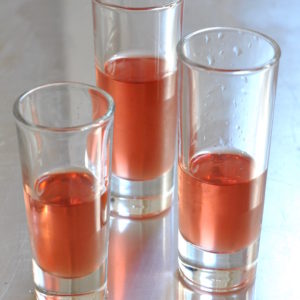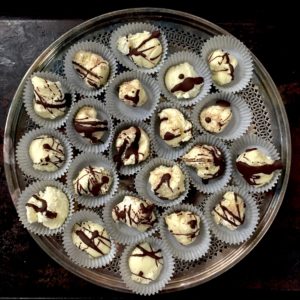Plum Liqueur
So, plum liqueur. I know, we just made cherry bounce. Why more booze? What gives? Do we have a problem?
Well, yes. We have many problems. Who doesn’t? But this is a food blog, and we’re discussing the steeping of fruits in alcohol, not our various woes. Why so many? (Not problems–infused boozes.) It’s summer, that’s why. The living is not necessarily easy, but berries and stone fruits are arriving at the market (I almost wrote “in profusion,” but how trite can a girl get?), sending members of the preserving tribe into high gear. And while one may brew up a round of cherry bounce and pound it right down, plum liqueur is a different story.
In a society where the latest vampire love story may be delivered to our doorstep via drone, plum liqueur asks us to wait. As fruit and alcohol exchange confidences, the sugar relinquishes itself. Depending on your viewpoint, this is either a poetic or annoying way of saying you need to wait for the fruit and booze to meld while the sugar dissolves. Minimally, this process takes two months, but will taste better if you can wait longer.

In all seriousness, I hesitated before offering another liquor recipe. But why lie? I wanted to make this, so I did. Besides, there are plenty of rhubarb recipes floating around the blogosphere right now. Do you really need another one from me?
Well, no, I hear you thinking, But I don’t need a recipe for infused booze, either. Fair enough. Why bother? Why wait for two months? Why not head out to Drinks’R’Us and buy a bottle of something comparable?
I recently dropped a pretty penny on a locally made pear brandy. Oh, it looked promising: black calligraphic letting on a heavy white label; said label affixed to an exquisite bottle, contents clear as mountain springwater. I opened and inhaled: essence of pear orchard wafted upward. Calgon! Take me away! Heedless of the hour–surely cocktail hour elsewhere, like Finland–I poured myself a tiny taste. Lovely…until I was assailed by heavy notes of chemical aftertaste. Much as I’d love to tell you this was symptomatic of my deeply sensitive palate, I’d be lying. The chemical wash was strong and disappointing. That pear brandy and its killingly hip bottle live under my sink, waiting hopefully for the day pear brandy chez chemical aftertaste is urgently required…..in something.

Homemade infused alcohols are purely luxury items. And therein, I suppose, lies the argument. (Excuse me while I get the door. The grammar police are here.) In the New York Times Cookbook, Amanda Hesser has this to say of making brandied peaches:
Canning fruit, like many domestic arts, has traveled the diminishing path from a technique universally practiced to a craft reserved for those with the luxury of time. But time is all we have, and I vote for spending that time eating delicious food.
Note Hesser says “eating delicious food.” Yes, plum liqueur needs time to find itself. Once it’s ready, please don’t wait for the perfect moment to decant it. That day will never arrive. Drink your plum liqueur on a Thursday in October or a Sunday in December. Please. Those days that aren’t July 4 or Christmas or New Year’s are the warp and woof of a life. Open the damned jar.
Plum liqueur comes to us courtesy of Diana Henry’s Salt Sugar Smoke, a treasury of recipes designed with germophobic American preservers in mind.

An entire chapter of Salt Sugar Smoke is devoted to “Syrups, Alcohols, Fruits, and Spoon Sweets.” Choosing just one was difficult, but I am quickly running out of storage space. Plum Liqueur had two things going for it: Eastern European roots that called to my own Russian heritage and a recipe headnote quoting Chekov’s The Siren. After a glass of plum liqueur, a character is transported from his armchair to Australia, where he sits “astride the softest imaginable ostrich.”
I suspect this experience will not be found in bought preparations.
A note about plum pits: this recipe calls for pitted plums. According to Homebrewtalk.com, whom I thank for this helpful information, plum pits taste extremely bitter and may also be toxic. So even if your plums have clinging pits, as mine did, please pit them. Do not risk the small possibility of making yourself or others ill and then say you weren’t warned. You were. Right here. Please pit your plums.
A note about yield: Henry’s recipe yields 2 quarts. Lacking such a large jar–and storage space–I divided the liqueur into two 1 quart jars. The photographs dramatically depict one of these jars in deep infusion action.

Plum Liqueur
Adapted from Diana Henry’s Salt Sugar Smoke
Preparation time: about 20 minutes to prepare, minimum 2 months steeping time
1 3/4 pounds ripe plums, preferably organic (about 12 plums)
2 cups white sugar
3 cups vodka
1 cup brandy (I used inexpensive Armagnac)
Recipe may be prepared in one 2 quart jar or divided into two 1 quart jars. Sterilize whichever size you prefer to use and have ready.
Wash and pit plums. Do not leave pits in fruit; plum pits are bitter and may be toxic. Cut fruit away from pits if necessary. Put fruit in bottom of jar(s). Add sugar and liquors. Screw on lid(s). Shake vigorously: it will look like an adult snow globe. Label and date jar(s). Store in dry, cool, dark place for at least two months, shaking occasionally to help sugar dissolve.
Liqueur will be ready to in drink in 2 months. Fruit may be strained out or left in jar so long as it is below alcohol level. Over time, liqueur will turn a soft pink.
Note: Henry’s recipe calls for 2 1/4 cups sugar. I prefer less sugar in my recipes, but feel free to increase amounts. She also suggests using superfine sugar if you wish. You may purchase this, or make your own by grinding regular white sugar in a spice grinder or food processor. It will dissolve faster.





